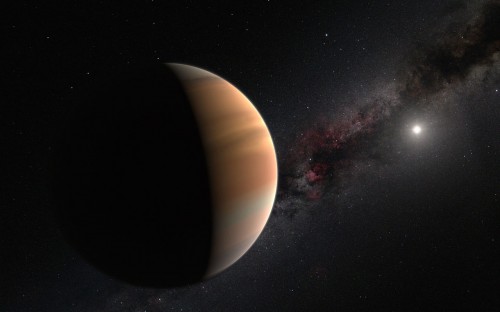
Is this exoplanet more of a Joanne than a Derek? You could soon be casting your vote to name 305 explanets. (Courtesy: IAU/M Kornmesser/N Risinger)
By Hamish Johnston
With the final two matches of the FIFA World Cup to look forward to this weekend, I thought I would sneak one more football-related story into the Red Folder. Over on the arXiv blog, there is a nice commentary about the topological nature of World Cup balls through the ages. Why? Well, two chemists in Taiwan have worked out a way to create a carbon-based molecule with the same shape as the football currently being used in the tournament in Brazil. Called the Brazuca, the ball is made from six panels that each have a four-leafed clover shape. Together, they form a structure with octahedral symmetry.
Now, Yuan-Jia Fan and Bih-Yaw Jin of the National Taiwan University in Taipei have shown that this shape can also be created by stitching together triangular pieces of graphene – sheets of carbon just one atom thick. While such a carbon molecule has yet to be created in the lab, there are precedents. The ball used in the 1970 World Cup in Mexico has the same shape as the “bucky ball” molecule of 60 carbon atoms first discovered in 1985, while the ball used in the 2006 tournament in Germany also has a molecular cousin. Fan and Jin describe their recipe for creating a graphene version of Brazuca in “From the Brazuca ball to Octahedral Fullerenes”.
Almost as important as the topological properties of footballs is the vexing topological challenge of stopping the cable for your headphones from becoming hopelessly knotted. That was the subject of a short piece on the television show Good Morning America, which covered the work of physicist Robert Matthews of Aston University in the UK. His idea for a tidier cable came out of a citizen-science project called “The Great British Knot Experiment” in which schoolchildren across the UK compared different types of knots to see which ones are easiest to unravel. You can watch the clip here.
At the moment, exoplanets – planets orbiting stars other than the Sun – have drab names like “COROT-7b” or “HAT-P-13b”, with the first bit of the name corresponding to the telescope used to discover the exoplanet. Now, the International Astronomical Union (IAU) wants to spice things up a bit by asking the public to suggest names for 305 selected exoplanets. Proposed names will be submitted by astronomy clubs and other non-profit astronomy organizations, then the public will be invited to vote for their favourites. The initiative is called NameExoWorlds and it’s described in this statement from the IAU.
Gliese 581g is one exoplanet that is probably not going to be getting a new name. That’s because it does not exist. The ex-exoplanet first hit the headlines in 2010, when astronomers announced that it was a rocky body in the habitable zone of its host star. In principle, this means that Gliese 581g could resemble Earth, have liquid water and harbour life – making it the first exoplanet we know to have these life-giving properties. But alas, a more recent study suggests that the exoplanet isn’t actually there. Instead, signals from stellar storms were mistaken for those coming from a planet. I suppose Gliese 581g already has a name, it is “The Exoplanet That Wasn’t There”.
Naming a retrograde exoplanet
Let me tell readers WHY I am interested in naming a *retrograde* exoplanet. There are some astronomers / astrophysicists who feel that exoplanets are turning planetary theories upside down. One such news is on a link of European Southern Observatory for the public, eso1016.
I am neither of them but as a teacher of students of age 15 to 17 (though now retired) – I think that there is a conceptual problem in the learning of circular motion and hence in the planetary motion as well. In a sense, our solar system is a troubling one and that is why that problem had remained unnoticed till the beginning of 20th century. However, it should have caught attention of teachers 100 years following the discovery of first retrograde moon of Jupiter – Pasiphae – in 1908. For more information, read first two points in a letter to the editor of CHANGE, May-June 2008, p. 5, title: Getting Science Right.
Now the discovery of *retrograde* exoplanets revives and strengthens my stand that, see my letter to the editor of Physics Education, UK, January 2012, p. 132. I hope above brief description can give the reader some idea of WHY I am interested in naming a *retrograde exoplanet*. If you have an idea, just reply on this site. For more discussion feel free to contact me using dvsathe@gmail.com
It may interesting to know that the “Brazuca” for the present FIFA World Cup was designed and made in Pakistan. Furthermore, it was shown through appropriate tests this Brazuca has better dynamical properties for the game than all the footballs used before.
Trackback: Physics Viewpoint | Molecular footballs, knotty headphones and a naming contest for exoplanets